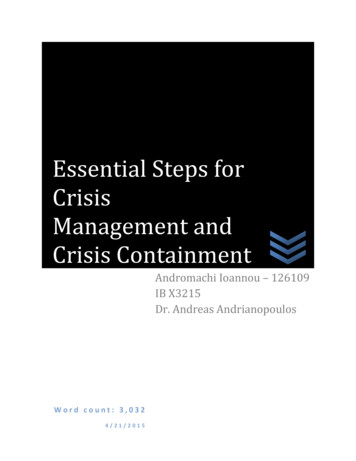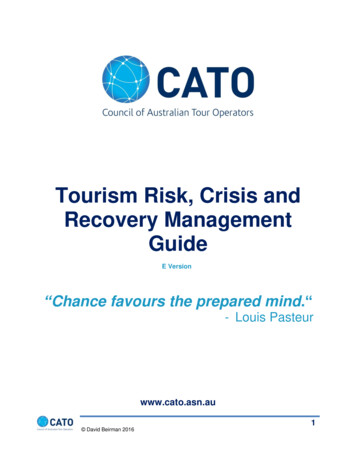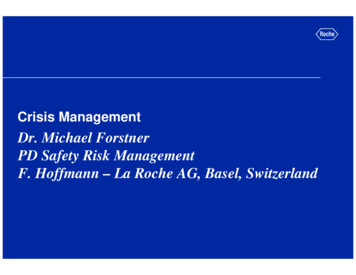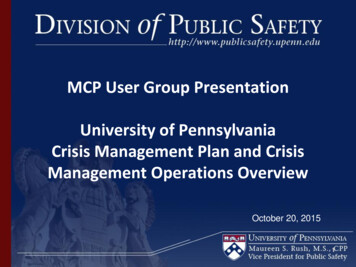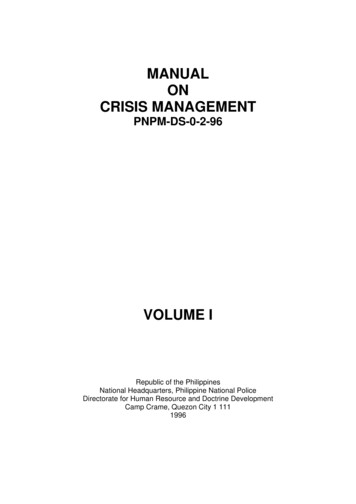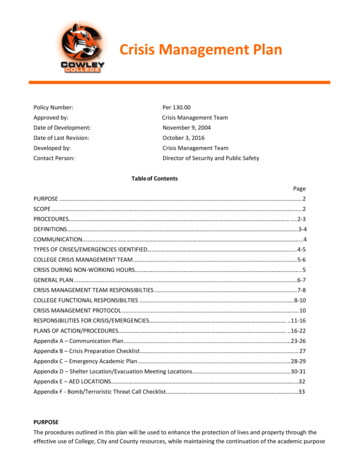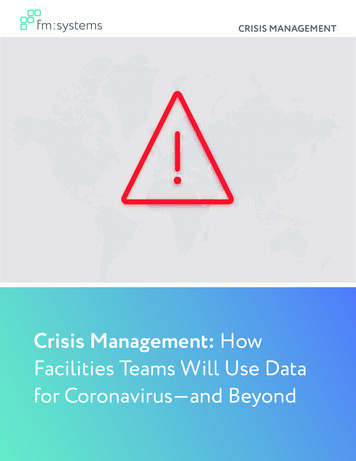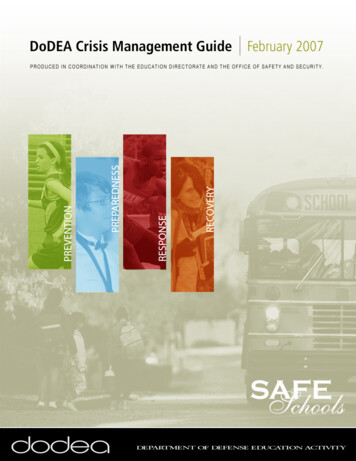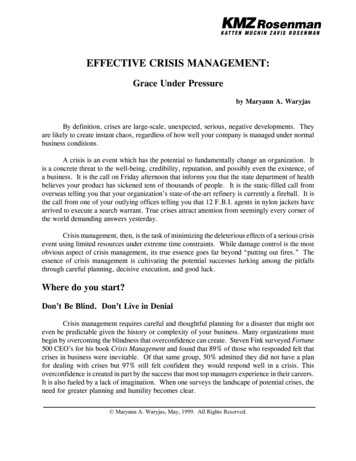
Transcription
EFFECTIVE CRISIS MANAGEMENT:Grace Under Pressureby Maryann A. WaryjasBy definition, crises are large-scale, unexpected, serious, negative developments. Theyare likely to create instant chaos, regardless of how well your company is managed under normalbusiness conditions.A crisis is an event which has the potential to fundamentally change an organization. Itis a concrete threat to the well-being, credibility, reputation, and possibly even the existence, ofa business. It is the call on Friday afternoon that informs you that the state department of healthbelieves your product has sickened tens of thousands of people. It is the static-filled call fromoverseas telling you that your organization’s state-of-the-art refinery is currently a fireball. It isthe call from one of your outlying offices telling you that 12 F.B.I. agents in nylon jackets havearrived to execute a search warrant. True crises attract attention from seemingly every corner ofthe world demanding answers yesterday.Crisis management, then, is the task of minimizing the deleterious effects of a serious crisisevent using limited resources under extreme time constraints. While damage control is the mostobvious aspect of crisis management, its true essence goes far beyond “putting out fires.” Theessence of crisis management is cultivating the potential successes lurking among the pitfallsthrough careful planning, decisive execution, and good luck.Where do you start?Don’t Be Blind. Don’t Live in DenialCrisis management requires careful and thoughtful planning for a disaster that might noteven be predictable given the history or complexity of your business. Many organizations mustbegin by overcoming the blindness that overconfidence can create. Steven Fink surveyed Fortune500 CEO’s for his book Crisis Management and found that 89% of those who responded felt thatcrises in business were inevitable. Of that same group, 50% admitted they did not have a planfor dealing with crises but 97% still felt confident they would respond well in a crisis. Thisoverconfidence is created in part by the success that most top managers experience in their careers.It is also fueled by a lack of imagination. When one surveys the landscape of potential crises, theneed for greater planning and humility becomes clear. Maryann A. Waryjas, May, 1999. All Rights Reserved.
Stages of Crisis ManagementStage One -- Pre-CrisisThe pre-crisis stage of crisis management is the most effort intensive and also the mostimportant. The buzzwords here are planning and prevention. Relying on wisdom, experience orsavvy alone is a formula for disaster. Preparation and forethought are the foundation of effectivecrisis management. Planning creates routine which in turn saves precious time.Identify Potential Crises -- They Can Happen to YouWhen your management team begins pre-crisis planning, you must first anticipate the kindsof crises your company and its various businesses could face. While every business has uniqueweaknesses, some generalizations are possible.Natural Disasters and Accidents. Natural disasters and accidents can affect any company.Included in this category are earthquakes for the West Coast, floods for the Midwest and the EastCoast, tornadoes for the South and the Midwest, hurricanes for the East and Gulf Coasts, blizzardsfor the North, and all of the above for international operations. Add fires, brown-outs, blackouts, explosions and crashes to the mix and you begin to scratch the surface of potential bad news.Strikes, Boycotts and Picket-Lines.Strikes, boycotts and picket-lines presentconfrontational situations in which employees, a labor union or some special interest grouppublicly announce their dissatisfaction with the company’s employee policies and practices,products, business practices or services. These are often orchestrated to maximize media attentionfor the protesting group.Product Liability Crises. With 20-20 hindsight, even the best quality control procedurescan be found to be flawed, or capable of being subverted. All manufacturers and distributorsshould be prepared for product tampering crises, product failure crises and product compromisecrises. Product compromise crises result from issues relating to product quality or product safety.Government and Other Investigations. The F.B.I. or another government agency arrivesat one of the Company’s offices to execute a search warrant. A disgruntled employee with a rabidattorney files a whistle-blower lawsuit alleging what at first seem to be outrageous, implausibleaccusations. The company’s outside auditors request an independent investigation of certainmaterial transactions or other perceived accounting irregularities. The CEO is accused of serioussexual harassment by several current and former employees. The CFO resigns under allegationsof financial impropriety. None of these may ultimately be proven true -- but what if there areenough bad or questionable facts and circumstances to seriously damage the company’s reputation,regardless of the ultimate outcome? Maryann A. Waryjas, May, 1999. All Rights Reserved.-2-
Business Crises. The results for the quarter are going to be seriously below management’sor analyst’s expectations. A customer who provides a material portion of the company’s revenueterminates a major contract. A key supplier has filed for bankruptcy, or has shut down operationsbecause of a strike. A disgruntled stockholder announces a proxy fight. A hostile tender offeris announced.Stopping at the obvious crises leaves a host of pitfalls untouched. Effective preventionmeans brainstorming for the obscure crises, which are potentially more dangerous because of theelement of surprise. As Norman R. Augustine said in his article Managing the Crisis You Triedto Prevent, “Tornadoes are caused by trailer parks. . . Survey the landscape continuously for‘trailer parks.’ That is, make a list of everything that could attract troubles to the business,consider the possible consequences, and estimate the cost of prevention.” He goes on to say thatmost businesspeople avoid this gloomy analysis because it is unpleasant. There will be items ona crisis list that are clearly beyond any manager’s control. But sidestepping the difficult issuescan lead to more grief down the line. While we cannot control the events which impact ourbusiness, we can control our response to those crises.Move beyond the obvious and confront the weaknesses within your organization. Can youabsorb the costs of litigation, the lost morale and the bruised reputation from sexual harassmentclaims resulting from a hostile work environment? Is your business particularly susceptible tolabor unrest? Are you dependent on a key figure like a CEO or founder? How would yourorganization react to the loss of senior management in a plane crash? Do you have a successionplan ready?Keep one eye on the headlines and one hand on the speed-dialer to your attorneys. Watchfor both societal trends and legal trends which could impact your business, including new legalremedies, changing theories of liability and regulatory shifts. The health care industry is currentlya prime focal point for government enforcement activity. Revenue recognition issues that haveplagued a number of software companies are likely to bring more scrutiny to public companyfinancial statements and the accounting standards in that industry. Civil penalties and criminalculpability for corporations are on the rise. Employment discrimination claims and environmentalregulation now seem commonplace. But what are tomorrow’s trends? When did the Year 2000appear on your radar screen? How many people were surprised to learn we had such an activeAntitrust Division at the Justice Department? Or that the increasing pressure to meet analysts’earnings projections might prompt the SEC and others to look ever closer at the method behindthe madness of corporate financial statements?Form a Crisis TeamOnce your management team has a feel for the kinds of crises you might face, the realplanning begins. The first step is forming a “Crisis Team.” The Team should have Maryann A. Waryjas, May, 1999. All Rights Reserved.-3-
representatives from all key areas of the business as well as open slots which can be filledstrategically based on the particular crisis.Core Crisis Team Members:CEO or a Team Leader from Senior ManagementCFOGeneral Counsel and Outside CounselCompliance OfficerSenior Managers from:Human ResourcesMarketing and SalesInvestor RelationsPublic Relations and Outside Public Relations SpecialistInformation TechnologyAdd Additional Team Members As Required:EnvironmentalPlant or Facility ManagersProduct SpecialistThe questions which help determine who is on the Team are “What will we need?” and“Who can get it for us?” The Team Leader should be chosen based on qualities like decisiveness,knowledge of the organization and accessibility. The Team Leader will be responsible forevaluating crises and assembling the Team, filling slots with specialists and ongoing coordinationthroughout a crisis.Crisis Team Info CardsOnce the Team is chosen, the next step is ensuring that no time will be lost on coordinationduring the crisis. Every team member and prospective team member (such as specialists), andtheir secretaries, should have a laminated phone list in their wallet or planner. This Crisis TeamInfo Card should include home and cell phone numbers for each Crisis Team member. Accessto the Team is crucial when time is of the essence. If your company has a central switchboard orcommunications center, that office should have a disaster protocol which clearly spells out whoto call and in what order to call them. A disaster phone tree should be created so that one personis not attempting to reach a host of people in record time. Put the disaster phone tree on the backof the laminated card. Maryann A. Waryjas, May, 1999. All Rights Reserved.-4-
Crisis CentralA central meeting place should be arranged in advance. Every company should have a“Crisis Central” identified at its headquarters. A very large conference room is often a goodchoice. The location must be accessible to all Team members and have access to primary andredundant communications. Missing resources only intensifies the time pressure. “CrisisCentral” should have access to all necessary support equipment during the crisis. Multiple phonelines, fax machines, mobile phone units and office support personnel should be made availableto the Team. Television sets and PCs with Internet access should also be provided. Dependingon the nature of the crisis, in the early stages your company may be dependent on media reportsfor information. If the crisis is centered away from the Team’s prearranged location,communications equipment must get to the crisis site as soon as possible at any cost. You shouldconsider having a “Local Crisis Central” which also has excellent access to primary and redundantcommunications. Credibility and reputation are easily lost when the people who are expected tobe in control have no information to share with their constituents.Relationships Are ImportantCultivate relationships with outside entities that you can tap during a crisis. Buildinggoodwill and defining the expectations and parameters of a business relationship are tasks bestaccomplished during the routine course of business and not during a crisis. These “CrisisPartners” include the specialists you might want on the Crisis Team as well as local supportpersonnel at business sites, including local law enforcement, fire departments and the media.Identify local sources of communications equipment near every plant site, and get the manager’shome phone number if possible. If your company is publicly traded, make sure you include yourcontacts at your exchange or Nasdaq. If the crisis involves injuries or property damage toindividuals or other businesses, do not forget local aid organizations, especially the Red Cross.These organizations are trained to answer the crisis call and can provide care, comfort and shelterthat the business cannot. Remember that the Team’s responsibilities do not end when theimmediate crisis is over. Local support organizations can help with post-crisis care and counselingif those services are needed.Do You Have a Document Handling Procedure?Another crucial part of pre-crisis management is an efficient and effective documenthandling program. This program should cover all “documents” whether written, recorded orelectronic. Executives must understand that litigation can be a crisis and that documents are thefuel for litigation. The smoking gun of old has been replaced all too often with the smoking email. When implementing a document handling or retention program, remember the followingthree guidelines: Maryann A. Waryjas, May, 1999. All Rights Reserved.-5-
1.Ask your executives and employees to imagine each and every e-mail and otherdocument they create on a 6 foot by 9 foot board in front of a judge or a jury, or on the front pageof The Wall Street Journal. Do they still want to send that e-mail, or create that memo?2.Documents intended for counsel should be marked as privileged documents andkept confidential.3.Make sure your company has a program for the destruction of documents whichare no longer active or required to be retained. The company’s counsel should be activelyinvolved in any document retention program because a complex web of regulatory requirementsregarding document retention exists in every industry. Of course, any document destructionprogram should be appropriately suspended with the issuance or impending issuance of asubpoena.Create a Written PlanFinally, take all the careful planning and reduce it to a written plan complete withcontingency options. Then distribute it in various forms to the potential players. Seniormanagement, the Board of Directors and the Crisis Team should have the complete Plan. AllCrisis Team members should have updated copies of the Plan at bo
EFFECTIVE CRISIS MANAGEMENT: Grace Under Pressure by Maryann A. Waryjas By definition, crises are large-scale, unexpected, serious, negative developments. They are likely to create instant chaos, regardless of how well your company is managed under normal business conditions. A crisis is an event which has the potential to fundamentally change an organization. It is a concrete threat to the .File Size: 357KBPage Count: 16
